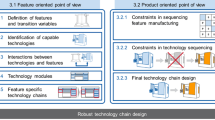Abstract
The optimization of technology chains is usually conducted as a local problem of each individual process step. However, in order to optimize the technology chain in terms of product properties a local optimization is insufficient and a more holistic approach is indispensable. Existing methods, which consider the manufacturing history of a workpiece, are often accompanied by a high level of effort in research. This paper presents a systematic approach to integrate the manufacturing history into the technology chain optimization process going along with a significant reduction of effort compared to existing methods based on simulation and experiments. Resulting from previous methods and models a set of representative variables is identified to describe interactions and dependencies within technology chains. Furthermore, an approach consisting of three steps is developed which allows a visualization as well as an explanation of the cause-and-effect relationships within technology chains. This approach is used to deduce two different optimization strategies for technology chains. The first strategy allows a global optimization by adjusting specified parameters without changing the processes within the technology chain. Whereas the second strategy comprises a redesign of the whole chain.








Similar content being viewed by others
References
Schulz W, Bischof C, Bobzin K et al (2012) Virtual production systems. In: Brecher C (ed) Integrative production technology for high-wage countries. Springer, Berlin, pp 241–434
Zaeh MF, Tekkaya AE, Biermann D et al (2009) Integrated simulation of the process chain composite extrusion–milling–welding for lightweight frame structures. Prod Eng Res Devel 3(4–5):441–451. doi:10.1007/s11740-009-0190-0
Brandes A (2008) Positionierung technologischer Schnittstellen. Beitrag zur ganzheitlichen Auslegung fertigungstechnischer Prozessketten, 1st edn. Berichte aus dem IFW/Institut für Fertigungstechnik und Werkzeugmaschinen, vol 2008,06. PZH Produktionstechnisches Zentrum, Garbsen
Zaeh MF, Papadakis L, Langhorst M (2008) Simulation of the manufacturing process chain of welded frame structures. Prod Eng Res Devel 2(4):385–393. doi:10.1007/s11740-008-0122-4
Denkena B, Rudzio H, Brandes A (2006) Methodology for dimensioning technological interfaces of manufacturing process chains. CIRP Ann Manuf Technol 55(1):497–500. doi:10.1016/S0007-8506(07)60467-3
Brinksmeier E, Gläbe R, Klocke F et al (2011) Process signatures—an alternative approach to predicting functional workpiece properties. Procedia Eng 19:44–52. doi:10.1016/j.proeng.2011.11.078
Wuest T, Klein D, Seifert M et al (2012) Method to describe interdependencies of state characteristics related to distortion. Mat-wiss u Werkstofftech 43(1–2):186–191. doi:10.1002/mawe.201100908
Straube A (2004)Modularer Ansatz zur Simulation verfahrensübergreifender fertigungstechnischer Prozessketten. Ph. D. Thesis, RWTH Aachen, Shaker Verlag, Aachen
Straube A, Messner G, Schmitz R (2004) Berücksichtigung der Werkstoffhistorie in der simulierten Fertigungsprozesskette. In: Simulation in der Produkt- und Prozessentwicklung. Fraunhofer IRB Verlag, Stuttgart, pp 31–37
Zaeh M, Kleiner M, Weiner K (2004) Simulation von Prozessketten zur flexiblen Fertigung leichter Tragwerksstrukturen. Zeitschrift für Wirtschaftlichen Fabrikbetrieb (ZWF) 99(5):248–252
Klocke F, Maier B, Tönissen S (2012) Methodik zur Identifizierung von funktionsrelevanten Oberflächen- und Randzoneneigenschaften in der Hartfeinbearbeitung. Ergebnisbericht des BMBF Verbundprojektes PlanPP. PLANPP. Apprimus Verlag, Aachen
Röttger K (2003) Walzen hartgedrehter Oberflächen. Dissertation, RWTH Aachen, Shaker Verlag, Aachen
Denkena B, Henjes J, Henning H (2011) Simulation-based dimensioning of manufacturing process chains. CIRP J Manuf Sci Technol 4(1):9–14. doi:10.1016/j.cirpj.2011.06.015
Schulze V, Osterried J, Strauß T et al (2012) Analysis of surface layer characteristics for sequential cutting operations. HTM J Heat Treatm Mat 67(6):347–356
Hirsch J (2006) Through process modelling. MSF 519–521:15–24. doi:10.4028/www.scientific.net/MSF.519-521.15
Klocke F, Pampus A, Zeppenfeld C (2007) Funktionale Oberflächen. wt Werkstatttechnik online 97(6):405–410
Lübben T, Zoch H (2012) Einführung in die Grundlagen des Distortion Engineering. HTM J Heat Treatm Mat 67(6):275–290
Nowag L, Sölter J, Brinksmeier E (2007) Influence of turning parameters on distortion of bearing rings. Prod Eng Res Devel 1(2):135–139. doi:10.1007/s11740-007-0009-9
Klocke F (2009) Manufacturing processes 2. Grinding, honing, lapping. Springer, Berlin
Surm H, Hoffmann F (2009) Influence of clamping conditions on distortion during heating of bearing rings. Mat-wiss u Werkstofftech 40(5–6):396–401. doi:10.1002/mawe.200900466
Ropohl G (2009) Allgemeine technologie. Eine Systemtheorie der Technik. Univ.-Verl, Karlsruhe
Klocke F (2011) Manufacturing processes, RWTH edition. Springer, Berlin
Suh N (1990) The principles of design. Oxford series on advanced manufacturing, vol 6. Oxford University Press, New York
Suh N (1998) Axiomatic design theory for systems. Res Eng Des 10:189–209
Suh N (2005) Complexity in engineering. CIRP Ann Manuf Technol 54(2):46–63
Denkena B, Tönshoff HK (2011) Spanen. Grundlagen, 3rd ed. Springer, Heidelberg
Eichgrün K Prozesssicherheit in fertigungstechnischen Prozessketten. Systemanalyse, ganzheitliche Gestaltung und Führung. Dissertation, Universität Kaiserslautern
Königs H (2009) IT-risiko-management mit system. Von den Grundlagen bis zur Realisierung; ein praxisorientierter Leitfaden, 3rd edn. Vieweg Praxis. Vieweg + Teubner, Wiesbaden
Pfeifer T (2001) Qualitätsmanagement. Strategien, Methoden, Techniken; mit 3 Tabellen, 3rd ed. Hanser, München, Wien
Johlen G (2003) Prozessoptimierung für die Hartfeinbearbeitung durch Kombination von Hartdrehen und Schleifen. Dissertation, Universität Dortmund, Vulkan-Verlag, Essen
Acknowledgments
The authors would like to thank the German Research Foundation DFG for the support of the depicted research within the Project KL 500/109-1 “Statische und dynamische Bewertung soziotechnischer Fertigungssysteme” and the graduate program 1491 ‘‘Ramp-Up Management - Development of Decision Models for the Production Ramp-Up’’.
Author information
Authors and Affiliations
Corresponding author
Rights and permissions
About this article
Cite this article
Klocke, F., Buchholz, S. & Stauder, J. Technology chain optimization: a systematic approach considering the manufacturing history. Prod. Eng. Res. Devel. 8, 669–678 (2014). https://doi.org/10.1007/s11740-014-0572-9
Received:
Accepted:
Published:
Issue Date:
DOI: https://doi.org/10.1007/s11740-014-0572-9



